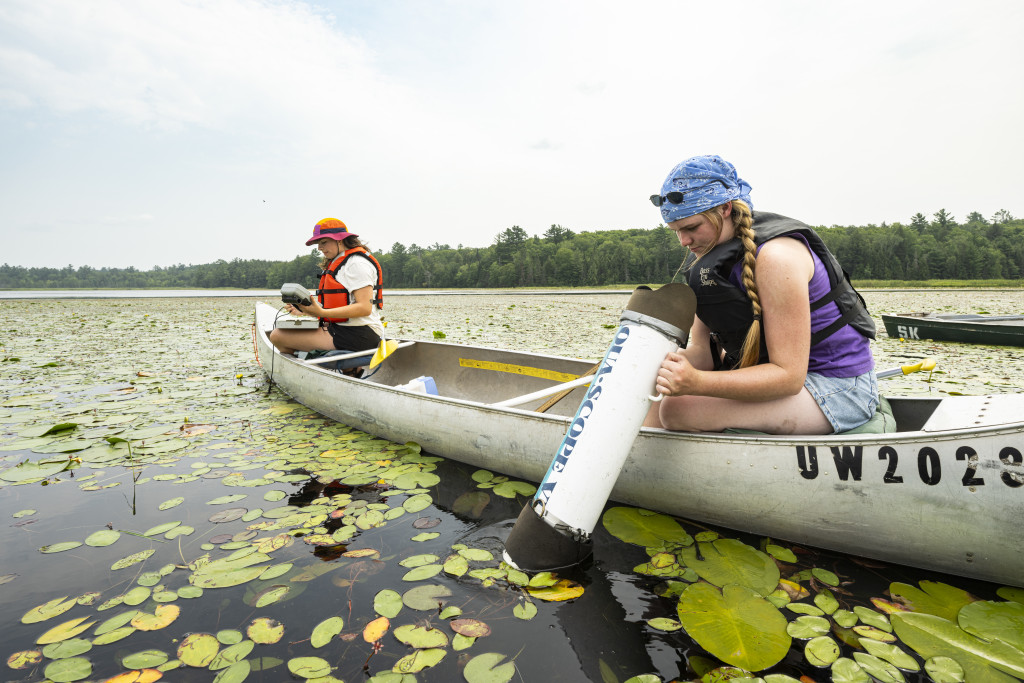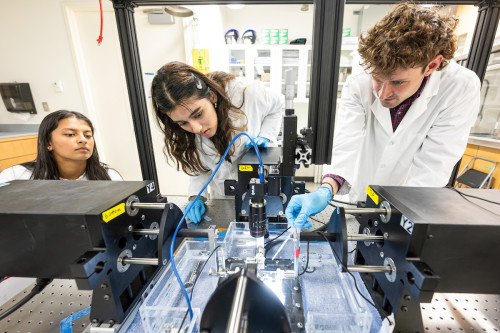UW–Madison 6th in national research ranking, surpasses $1.7 billion in research expenditures

UW–Madison students Eliana Cook and Marin Danz collect data as part of a wild rice study at Allequash Lake near the Trout Lake Research Station south of Boulder Junction, Wis., on July 30. For the first time, UW–Madison has topped $1.7 billion in research expenditures. Photo: Bryce Richter
The University of Wisconsin–Madison has moved up two places to sixth out of 920 public and private universities in the United States in university research expenditures, according to the National Science Foundation’s annual rankings.
For the first time, the university has topped $1.7 billion in research expenditures, according to the NSF Higher Education Research and Development (HERD), released today, Nov. 25, 2024.
“UW-Madison has been a research powerhouse for generations,” says UW–Madison Chancellor Jennifer Mnookin. “This latest increase in both our research expenditures and our HERD ranking is further evidence of our deep commitment to bringing incredible UW–Madison expertise across disciplines to the grand challenges of our time and to translating our discoveries to improve lives at home in Wisconsin and beyond.”
The NSF’s data show a 13.7% increase in research expenditures at UW–Madison over the previous fiscal year, an increase of more than $208 million for the period covering July 2022 through June 2023. Nearly half of UW–Madison’s $1.7 billion in total research expenditures comes from federal awards, from agencies such as NSF, the National Institutes of Health and the Department of Defense.
Chancellor Mnookin and the Office of the Vice Chancellor for Research have prioritized improvements to the university’s annual research expenditures.
“UW–Madison’s research success, as evidenced by the HERD Survey, includes collaborative efforts to connect faculty to more funding opportunities,” says Vice Chancellor for Research Dorota Brzezinska. “We are increasing campus engagement with our partners and fostering an entrepreneurial environment that supports our commitment to advancing scientific discovery and facilitates researchers moving their innovations from lab to marketplace. We are seeing increased support for research into Alzheimer’s, childhood asthma, combating the fentanyl crisis, and traumatic brain injuries. We are combining data-driven diagnostics and innovative technologies to develop highly targeted cancer treatments with investments in areas such as precision medicine.”
For instance:
- A $29 million award from the National Institutes of Health will study and treat diseases known to cause blindness.
- A $19 million, 4-year award from the USDA is allowing UW–Madison’s Dairy Research Center to pursue innovations to help Wisconsin’s dairy industry to grow and thrive.
- A $15 million award from the U.S. Office of Naval Research to a research group in the College of Engineering is funding pioneering efforts to understand, detect and prevent traumatic brain injuries.
- A $22.3 million, 3-year award from the Robert Wood Johnson Foundation is allowing the Population Health Institute in the UW School of Medicine and Public Health to expand its work on community health.
Additionally, UW–Madison research is improving the economics of fusion energy systems while supporting communities affected by the technology and is leading to the expansion of a statewide network of approximately 90 weather and environmental monitoring stations across the state to aid farmers and others.

Daniel Pearce (right), graduate student in biomedical engineering, works with students on a testing sample in a lab in the Engineering Centers Building. Photo: Bryce Richter
While academic research funding at UW–Madison comes primarily from federal government and institutional support, the university also relies on state and local government, industry, non-profit and foundation support. The two most significant non-profit contributors of research funding at UW–Madison are the Wisconsin Alumni Research Foundation and the UW Foundation.
In 2025, WARF’s support for UW–Madison research will total $159.8 million. WARF has also committed $15 million over the next three years to extend UW–Madison’s strength in artificial intelligence research and education by supporting the university’s Research, Innovation and Scholarly Excellence Initiative focus on AI, called RISE-AI.
RISE is a multifaceted effort Chancellor Mnookin announced in February 2024 to build upon the university’s strengths in researching and addressing complex challenges of importance to Wisconsin and the world. The initiative is focused on strategic faculty hiring, enhancing research infrastructure, improving interdisciplinary collaboration and increasing student and educational opportunities.
In addition to a focus on AI, in 2024 Chancellor Mnookin also announced RISE-EARTH (Environment: Adaptation, Resilience, Technology, and Humanity), to address challenges and opportunities related to the environment, and an effort focused on health, called RISE-THRIVE (Transforming Healthspan through Research, Innovation, and Education), which is prioritizing investments into research to improve the human health span, including new treatments for diseases ranging from Parkinson’s to cancer.
UW–Madison research is making a significant impact on Wisconsin communities, according to data from the Wisconsin Idea Database project. The project highlights connections between UW–Madison and the state of Wisconsin, including community partnerships and projects, financial relationships and more. UW–Madison partners with more than 3,000 state businesses and organizations yearly, spending at least $360 million on goods, services and grants.

Equipment operator and staff member Sam Perez collects a sample of potatoes from cold-bin storage as he prepares to conduct biweekly, quality-control lab tests on a variety of chipping potatoes at the University of Wisconsin–Madison Hancock Agricultural Research Station (HARS) in Hancock, Wis. Photo: Jeff Miller
Additional UW–Madison gains in fiscal year 2023:
- Federal research expenditures grew 10% to $816 million.
- Institutionally funded research expenditures grew 17% to $543 million.
- Non-profit support was up 20% to $153 million.
- State and local government spending was up 14% to $126 million.
- Industry-sponsored research expenditures were up 14% to $46 million.
- Several interdisciplinary centers at UW–Madison received federal funding renewals in fiscal year 2023, including the Space Science Engineering Center, the Institute on Aging, and the Wisconsin Energy Institute.
More about HERD
The annual survey is the primary source of research expenditure data at American universities and colleges and is just one way to measure academic research activity. Each year, it collects information on expenditures by research field and funding sources among institutions that spend at least $150,000 on separately budgeted research and development in a fiscal year. The survey also compiles information on the types of research expenses and the number of research and development personnel at each institution.




